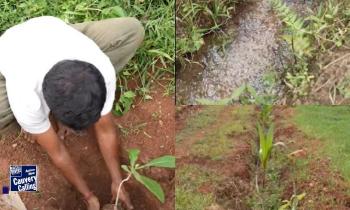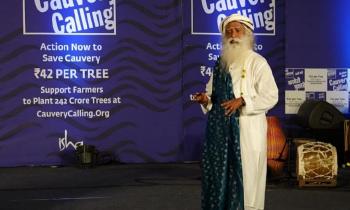Has Rain Reduced In India?
With city after city falling prey to acute water crisis, it is natural for us humans to assign the cause to the vagaries of rainfall. But is that the real reason?

The simplistic answer to this question is, NO.
Then the next question is, why are there dire water situations in cities like Chennai, where people are fighting over water, where one of them was actually killed in a “kozhai sandai” (“water-tap fight”)?
And let us not forget that at the same time, in other parts of the country, people face the other extreme --- unmanageable floods (from torrential rains) like in Assam, Mumbai and the Konkan coast this year.
Mind you, all of this is happening in the same country during the same monsoon period.
There have been enough studies done about Indian monsoons, the most recent one being the study by the IITs (Indian Institute of Technology - Chennai, Bombay and Mandi) about the patterns of Indian monsoon.
The report of this study is an outcome of studying Indian monsoon for over 100 years. There are also other studies that focus on the amount of rain that Indian monsoons have been bringing to us over a long period of time.
Quantum Of Indian Rainfall Is The Same Over 100 years
The studies on long-term rainfall trends has shown that the quantum of rain has been consistent for India as a nation, that is, overall we as a country receive the same amount of rain now as we received 100 years ago.
But --- and this is a huge ‘but’ --- when these rains occur and their duration has changed a lot, according to a study conducted in the long term rainfall trends in India.
While the study has revealed no significant change in seasonal, annual or monthly rainfall patterns in the country, increasing and decreasing rainfall patterns were detected in certain regions during certain months.
However, the increases and decreases seem to cancel each other out, thus maintaining status quo in overall rainfall quantity.
The Indian monsoon spans four months, from June to September. The country receives 80 per cent of its total rainfall during these months. In the months of June and July, there were as many regions showing an increase in rainfall as there were those showing a decrease in rainfall.
August showed more increases than decreases while the reverse was true for September. Even though annual and seasonal rains seemed to have decreased, unseasonal rains showed an increase with more winter rain and pre- and post-monsoon rain recorded nationally.
Also, although a decrease has been noted nationally in the first two months (June and July) and the last month (September) of the monsoon season, August has shown an increase.
Changing Patterns Of Indian Monsoon And Their Unpredictability
Another recent study on Indian monsoon’s pattern suggests that there is a triennial oscillation of the Indian monsoon. That is, the Indian monsoons typically follow a three-year pattern.
In other words, the same pattern of rainfall in a region will occur every three years. Intuitively and by sheer observation, Indian farmers who have practiced agriculture in these monsoons for over decades are aware of these patterns too.
However, according to Pravat Jena, now these patterns are no more predictable across large areas of the country. This means that a farmer who used to sow and harvest a crop in stipulated time periods, now doesn’t know if the rains will come when sowing is done and if there will be a fruitful crop at all.
Global Phenomena Affecting The Monsoon: The Land And Ocean Temperature Difference
Monsoons across the Indian subcontinent have weakened due to rising ocean temperatures. The Indian Ocean is said to be getting warmer. This is weakening the movement of cooler ocean air to the land.
Since it is this movement of air that creates rain-bearing clouds, the result of the weakening air movement is diminishing monsoons over South Asia, making it one of the most vulnerable regions in the world for natural disasters.
All of the above changes that we are observing to Indian monsoon are not natural phenomena. All of them are due to drastic changes in human activities on this planet.
And our activities have managed to affect something as big and complicated as our rains, in a mere century. We have managed to significantly affect the grand natural phenomena of the life-giving monsoons.
Is There A Solution To This Crisis?
Trees are the solution to this crisis.
Trees have a significant impact on stabilizing precipitation patterns through evapotranspiration – a process by which water is transferred from land to the atmosphere by evaporation and transpiration.
Evapotranspiration actually seeds the passing rain clouds, making it rain in and around the tree cover itself.
The impact of forest-derived evapotranspiration can be seen in satellite observations of rainfall: over most of the tropics, air that passes over forests for ten days typically produces at least twice as much rain as air that passes over sparse vegetation. Higher relative humidity has likewise been found to raise the likelihood of precipitation.
A lesser-known but significant impact of the tree cover is its condensation effect. This condensation effect created by the tree foliage also adds to substantial amount of water harvested from the humidity in the environment.
In all, trees and forests help in increasing the number of rainy days by stabilizing precipitation patterns.
This article is part of the Cauvery Calling series.
About Cauvery Calling
Cauvery Calling is a first of its kind campaign, setting the standard for how India’s rivers –the country’s lifelines – can be revitalized. It will initiate the revitalization of the Cauvery river by supporting farmers to plant 242 crore trees in the river basin.
This will increase water retention in the basin, while improving the income of farmers by 3-8 times in 5-7 years and transforming the lives of 84 million people.
Visit: CauveryCalling.org or call 80009 80009. Contribute to Cauvery Calling. Use #CauveryCalling on Twitter.
Praveena Sridhar is a Lead Policy Expert at Rally for Rivers, Isha Foundation, and has several years of rich and diverse experience in water and related sectors. She has been a UNICEF consultant for a water and sanitation program and a consultant to other multilateral agencies and nonprofits.











